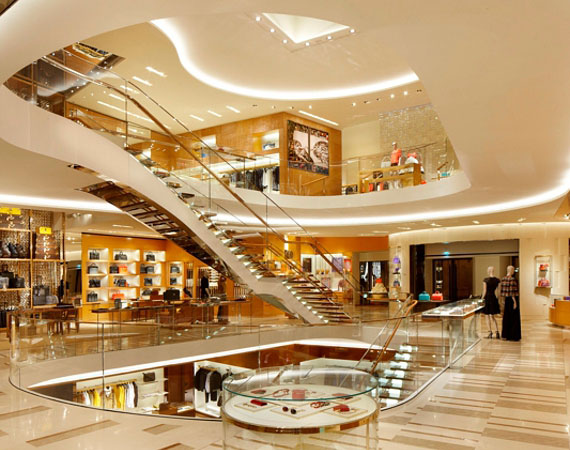Steven Fischer, director of Image, Style & Design Studio, debates the merits of global consistency versus localised individuality when it comes to luxury brand strategy

Steven Fischer, director of Image, Style & Design Studio, debates the merits of global consistency versus localised individuality when it comes to luxury brand strategy
Burberry’s Chicago flagship store
Steven Fischer, director of Image, Style & Design Studio, debates the merits of global consistency versus localised individuality when it comes to luxury brand strategy
As the thirst for luxury consumption returns after the effects of the global financial crisis, many luxury brands are licking their chops, readying new ways to entice consumers, looking to conceptualise innovative retail locations and flood the market with new products.
A key question arises at this point in the evolution of luxury: does luxury need to be individualised & localised? Or can it be “mass-customised”? And in terms of strategic focus, should brands champion consistency or authenticity?
Take the luxury hotel industry as an example. Stalwarts such as The Four Seasons pride themselves on providing a consistent experience wherever one is in the world. One can walk into the Four Seasons in Marrakesh, and expect a similar experience to one found at the Four Seasons Tokyo.
“ One can walk into the Four Seasons in Marrakesh & expect a similar experience to one found at the Four Seasons Tokyo ”
In fact, if you have stayed with the brand before, the hotel will already know your preferences for rooms or pillows, even allergies or dietary requirements. In essence, doing their utmost to provide the experience you have come to expect.
The service will be remarkably similar, from the ambience down to how the staff converse with you. It can be considered a home away from home, always consistent. The same can be said for McDonalds. One can go to the original McDonalds in Des Plaines, Illinois and have the same general experience as McDonalds in London. After a long journey, sometimes consistency is desirable.
In contrast to the Four Seasons model, consider the Dorchester Collection of hotels. A hotel group focused on taking an iconic hotel, in a particular location, and reinforcing the unique components of that hotel, essentially respecting what makes it special.

The Presidential Bungalow at the Dorchester Collection’s Beverly Hills Hotel
It does this while retaining the original name of the property, and providing a guest with the sense that the particular hotel is a home within an otherwise foreign place. The Beverly Hills Hotel has always maintained its classic pink colour motif throughout, but that colour motif hasn’t been replicated in other Dorchester Collection properties.
Dorchester’s director of organisational performance Ana Brant explains that many of the hotel employees have worked for the company for an average of 10-12 years. Suggesting that their length of service is a testament to the care and appreciation they have for the hotel. This strong commitment results in a sense of genuine warmth and genuine engagement with the guests. This “special” and “unique” component is a key differentiator for The Dorchester Collection.
On the retail front, almost every major luxury retail street in the world feels remarkably similar, and the major brands do a fantastic job of providing a consistent experience on a global scale. Essentially their stores are designed to showcase a global brand vision, which is often not in keeping with the local tradition. Perhaps this is a lost opportunity?
“ Stores are designed to showcase a global brand vision, which is often not in keeping with the local tradition ”
Right in my hometown of Chicago, last fall Burberry opened its newest global flagship store to much fanfare. A new construction, designed completely in-house, under the direction of chief creative officer Christopher Bailey. The boutique looks like nothing else on Michigan Avenue. Instead it is an amalgamation of architectural styles – New York, Los Angeles, London, Milan and Tokyo all put together.
It certainly stands out along the Magnificent Mile as it looks like nothing else on the street. Whether it is fitting for a city with such a strong architectural identity as Chicago could be up for debate. From a consumer perspective, this presents a challenge. If a brand wishes to distinguish itself from the competition it might be better to embrace localisation, and respect what makes the experience unique.
Louis Vuitton is doing just this with its “Maison” flagship shops. Most recently, they opened two of these special experiential spaces – in Venice and Munich. In both cases, Vuitton took great pains to restore an existing architectural masterpiece and to respect local heritage, whilst working within its own brand architecture.

Louis Vuitton Maison Etoile, Rome
While doing so, Vuitton is adding cultural experiences to the local area, deepening its conversation with consumers. In its Rome “Maison”, it has a movie theatre that celebrates classic Italian cinema. One gets the true feeling that one is in a special place and experiencing something unique.
Michael Burke, chairman and CEO of Louis Vuitton remarked that these special experiences “are not directly related to our business and this is not at all our aim” (Women’s Wear Daily 4/23/2013). In other words the brand is working to encourage a unique discovery experience, rather than to exclusively move product from shelves.
Many successful luxury brands have emphasised the experience that one derives from participating with the brand. Mass-customised luxury experiences provide a consistency; individual- and local-focused experiences provide distinction and uniqueness. Which will win out remains to be seen.
To further investigate luxury brand strategy on Luxury Society, we invite your to explore the related materials as follows:
– Logo Driven Luxury Brands Look to Reduce Visibility
– The New Luxury is Luxury For All, Suggests Jean-Noël Kapferer
– How Premiumisation Has Made The Impossible Dream of Luxury Possible










